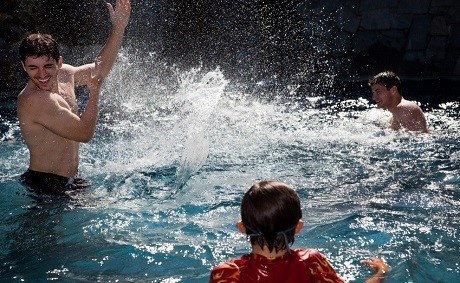Additional measures to prevent liquid losses from your backyard resort

Part 2 of a 2-part series on swimming pool water conservation
Fighting evaporation is crucial to making your pool water-efficient.That’s why we outlined specific tips for cutting this major source of water loss in part one of this article series.
Along with reducing evaporation, it helps to preserve water that may be escaping your pool by other means. Because some of these ways are less obvious and can be tricky to detect, many pool owners never consider them.
Let’s take a look at the troublesome, sometimes surprising, escape routes that pool water can take—and what you can do to stop or slow them down.
1. Identify and repair any leaks.
Have you have implemented tactics to cut evaporation, but protecting pool-water levels remains a challenge?
Well then, finding any leaks should be at the top of your hit list. Left unchecked, an ongoing leak can consume hundreds of gallons of water.
Watch for any areas where water could be exiting the pool or equipment lines. Sometimes, monthly water bills provide a clue there’s a leak; carefully review your statements for any sudden surge in the regular amount.
Without a tip off from your utility bill, there’s a simple trick to check if your pool is leaking: Mark the current water level on a tile along the interior perimeter; either place a piece of tape on it or mark it with a water-soluble grease pen. Now monitor it.
After 24 hours, look at how much it lowers; if the water level drops more than a quarter of an inch, chances are that more than routine evaporation is at play. A leak might be present. The most common places they develop are skimmers, pipe valves, return jets, main drains, and lighting fixtures.
In some cases, leaks can be hard to locate. If you are unsure that one has formed or if you are confident that one has—but you can’t find it—don’t take chances; call a professional leak-detection company that specializes in hunting them down.
Once the source is pinpointed, you may need a service tech or a contractor to repair it. In some cases, the fix is relatively simple. Examples that take just minutes include tightening a pump fitting or replacing an O-ring in an equipment valve.
Other leak solutions are tougher and more labor-intensive. Difficult ones are those occurring in plumbing lines that are underground. Challenging too, are leaks within the pool walls, around the return lines, inside lighting niches, and along the tile line.
2. Properly maintain your pool water.
Good pool-water management can help prevent a colossal episode of water loss. If you fail to maintain the chemical balance, the risk increases for calcium damage to pool plaster. Two kinds of plaster issues can trigger pool-water Armageddon. Here’s how.
Plaster contains calcium, and if the mineral level in the pool is too low, the water draws calcium out from the plaster—creating unsightly etching in the material. Fixing these blemishes may require power-sanding the entire pool interior.
Another problem comes when calcium levels are too high. Mineral deposits grow in and around your pool, forming crystals on the plaster surface. Commonly referred to as “scale,” this buildup creates grey, white, or brownish spots and shadows throughout the pool’s interior.
If you catch the calcium buildup early on, you may be able to address it by brushing it away and by correcting your water balance. However, if the buildup remains neglected, your pool plaster may become unsightly, and may require an acid wash or even a complete re-plaster.
Now, here’s the rub: To power-sand, acid-wash, or re-plaster a pool, you must completely empty it—sacrificing thousands of gallons of water! Talk about conservation efforts going down the drain!
Don’t let that happen! Ward off calcium threats, plaster catastrophes, and a forced pool draining. Implement ongoing, appropriate pool-water treatment that includes regular monitoring of your pool’s pH, alkaline, and calcium hardness levels.
3. Minimize the pool water splashing out.
While we all love splashing, water fights, cannonballs, and jack-knife dives, they unfortunately lead to a whole bunch of water leaving your pool. To prevent—or at least reduce—this from occurring, you may need to create and enforce some new pool rules.
Most adults can resist temptations like boisterous water play or using a diving board (if you have one). However, kids may have a harder time adapting to additional restrictions for pool conduct.
Depending on the children’s age, you may want to use these new guidelines as an opportunity to explain the importance of conservation; this way, they gain some understanding of the reason for the new rules—and they might be a bit more cooperative with adhering to them.
Another option is to seek alternative ways for youngsters to pass time in the pool. Ideas might include providing inflatable pool toys for floating or encouraging pool games like Marco Polo or Scavenger Hunt. These approaches can help keep everyone occupied and having fun, while keeping water from going airborne and leaving the pool.
If you have dogs that like jumping in the water to cool off on hot days, it’s a good idea to supervise them as well. Canine hair soaks up water. In addition, your updated pool rules may need to include a ban on tossing balls and toys into the water for your pooch—no more doggie dives for retrieval missions.
4. Clean your sand or DE filter only when really needed.
Common pool filters include sand and DE (diatomaceous earth), and both require routine care to prevent debris over-accumulation and troublesome clogs. However, the only way to clean a sand or DE filter is with the water-guzzling method known as backwashing.
In this process, you reverse the flow of pool water through the filter. This reverse movement pushes away dirt and debris from the filter. Then, the dirty, contaminated water is sent through a pipe connected to the filter—and out of the pool.
Backwashing can take only a few minutes to complete, but for a typical pool, it consumes approximately 200 to 300 gallons of pool water! So, while your filter is losing unwanted dirt and debris—your pool is losing a ton of water. And that’s for a single backwash. Most DE and sand filters require a backwash three to five times per year!
Don’t neglect your filter, but do be judicious in how frequently you clean it. Doing so is necessary only when storage is near or at storage capacity. Before initiating a backwash, be sure your filter truly needs it.
To determine when your filter is ready for some housekeeping, check the pressure on its gauge: If it reads 8 to 10 psi above the normal starting pressure, it means that the internal dirt-holding capacity is filling—and yes, it’s time for a backwash. Keeping an eye on the gauge can help you avoid needlessly expending water on a still-relatively clean filter.
Bonus tip:
When you must backwash, recycling the water may be an option. This opportunity is available if your pool relies on ozone and/or ultraviolet light for purification—thereby using only trace amounts of chlorine. If it does, your virtually chemical-free pool water can safely be used to nourish your lawn and plants!
5. Change your filter to a cartridge model.
Now that you understand how DE and sand filters squander water, consider replacing yours with a cartridge type. This savvy move will save thousands of gallons of water. That’s because cartridge filters do not require a water-hogging backwash to get clean!
To expel dirt and debris from a cartridge filter, simply open the filter tank and remove the cartridge. Give it a quick wash with a garden hose. While this process might take 20 to 30 gallons of water, that amount pales in comparison to the couple hundred gallons required with backwashing.
For even better water-sparing results, choose an oversized cartridge filter. With maximum dirt-holding capacity, large models can go much longer in between cleanings. Therefore, their needed frequency for hosing down—as well the effort on your part—is minimal. In fact, some oversized filters can store so much debris that they need cleaning only once or twice a year!
Summary
Homeowners in some regions of the country need to be particularly conscious of water usage. However, even in places more fortunate to have ample water supply, conservation is still a good idea.
Often, the single most impactful tactic is to tackle evaporation with a pool cover. If you do nothing else, this alone will deliver major savings.
While evaporation is typically the chief factor for why water levels drop, it’s not the only one. It is important to vigilantly monitor all possible reasons for your pool’s liquid losses.
By doing so, you can take steps to ensure more water remains in your pool for as long as possible. This way, your pool is water-efficient. More water remains inside the pool where it belongs, and refills are needed as infrequently as possible. Both your wallet and Mother Nature will thank you.




.jpg?width=1490&name=rock-waterfall-slide-pool%20(1).jpg)